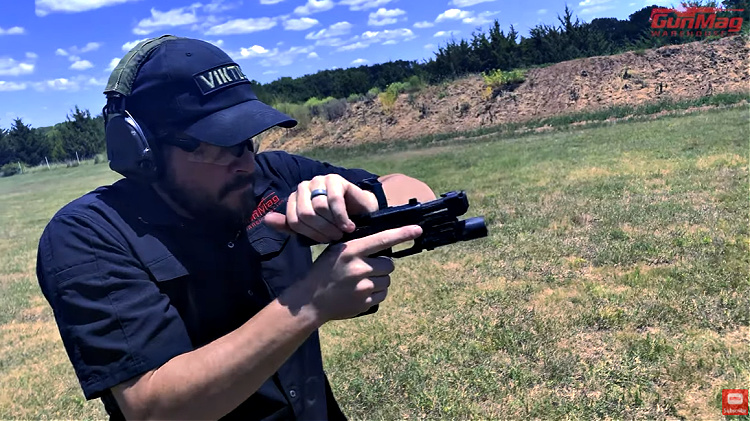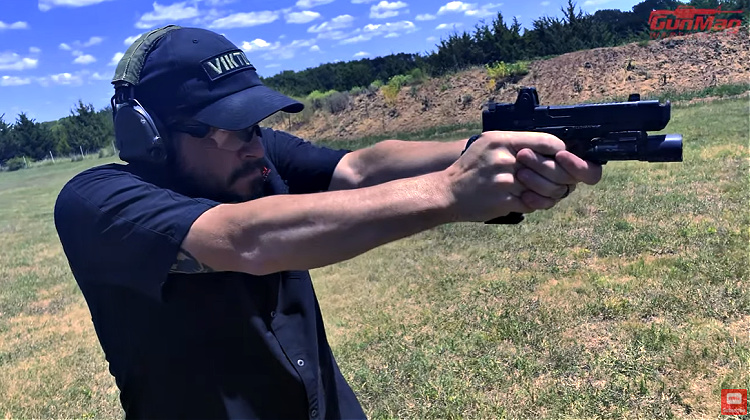We all need to train. Me, you, everyone. That includes what to do when you expect a “bang,” but get a “click” instead. I readily admit that I don’t work on this enough. Do you? Fortunately, it’s something we can easily train for with dry fire and snap caps. In this video, Daniel Shaw from Gun Mag Warehouse takes us through the simple progression:
Failure to fire (FTF, which can also mean Failure to Feed) can be caused by a number of things:
- Bad ammo
- Bad primer
- Bad magazine follower
- Accidentally hitting the mag release while firing
- Perhaps your gun needs to be serviced
These can be addressed using a simple procedure that Daniel demonstrates for us: the Tap Rack Bang drill.
- Tap: Actually, it should be more like “smack the crap out of” to make sure your mag is properly seated in the magazine well.

- Rack: Rack the slide to chamber a round and reset the striker or hammer.

- Bang: Fire the gun.

Tap Rack Bang will solve most FTF situations.
At the very least, it will help you diagnose your problem. If you have bad ammo, racking the slide will eject the unfired round and chamber another. If it still won’t fire, maybe you have a bad batch with faulty primers or perhaps there is a problem with your gun. If the problem was with your magazine, smacking the bottom may reseat the mag, allowing you to strip off another round when racking the slide. If it still won’t chamber a round, you may have a bad magazine follower. “Bang,” obviously, is the final step and the signal that you’ve most likely solved your problem. This is a great procedure to clear what is often referred to as a “Level 1 Stoppage” or begin to diagnose what your problem is.
If you get the “click” and your gun does not fire, MAKE CERTAIN TO KEEP THE GUN POINTED IN A SAFE DIRECTION WHILE YOU CLEAR IT. I cannot emphasize that enough, which is why I put it in all caps. That should be the case anyway, but people tend to turn around and start fiddling with their guns. This is particularly prominent with new shooters who may be looking for help. I expect most of us have witnessed such things at the range. Don’t be that guy. Keep the gun pointed downrange while clearing the malfunction.
But check your gear, too.
Obviously, part of this can be avoided by purchasing quality ammo, but with things the way they’ve been the last couple of years, we often take what we can get. Just be aware of the potential for problems when shooting old or cheap ammo. Another step you can take to minimize these problems is to buy quality mags. Look, I get it. Mags are often expensive, especially if you buy them from the manufacturer. Life would be a lot simpler if everything took Glock mags, but they don’t.
When I first got into autoloading pistols and modern sporting rifles, I had to learn the hard way that you get what you pay for with mags, just as you do with guns and ammo. Spending a little more on quality mags and keeping your eyes open for good mags on sale will save you some trouble. It will also save you money in the long run since you won’t be spending your dough on crappy mags before having to buy the good ones.
Also, remember that mags are a commodity.
They wear out and have to be replaced. Checking your mags occasionally and rotating them often can extend their life. Nor does it hurt to clean them every once in a while. Personally, I have all my mags numbered and labeled by gun. That helps me keep up with the rotation and lets me easily identify one that may be ready for replacement. I just use a silver paint marker. That also helps me keep up with them if I’m working in a training class and have to go back and pick them up off the ground.
Dry Fire Training
The “Tap, Rack, Bang” drill is easily done with Snap Caps in dry fire exercises. Just watch the quick video above to see how it’s done. It doesn’t take long to get in a bunch of reps, and you may save yourself headaches on the range, and, just maybe, it might save your life in the real world.



